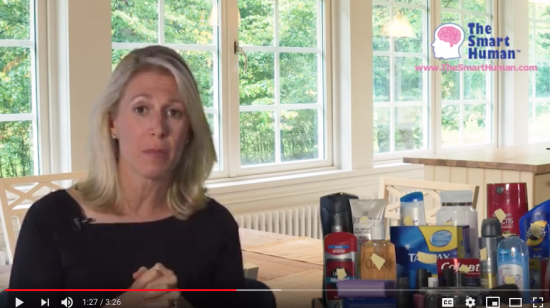VIDEO: Chemicals In Personal Care Products
In this video, Dr. Aly Cohen, founder of The Smart Human, discusses the chemicals in our personal care products.
To begin with, and this is key, personal care products and their ingredients are not regulated in the United States. That’s right. Under the 1976 Toxic Substances Control Act, all of those products that we rub, lather and spray onto our body require no testing for safety or toxicity before going to market. We have no idea of their reproductive risks, developmental issues in children, cancer risks or risk of causing endocrine disorders. And the ingredients that we know now do have those effects have not been removed or banned. It’s up the the manufacturer to do voluntary testing and share results with consumers. And only they, not the FDA, have the authority to remove their product from store shelves if it’s found to cause harm.
Since 1976 only 11 chemicals have been taken out of cosmetics in the United States. The European Union has restricted 1100 chemicals in their products since the 1970s, most of which we still use in US products. Many chemicals in personal products contain endocrine disrupting chemicals or EDCs that can alter hormone levels in the body. Others contain preservatives, coloring, metals such as lead and mercury. Added fragrance or perfume can contain hundreds of individual chemicals but we as the consumer are not allowed to know the specific ingredients because fragrance is considered proprietary or trade secret in the US. But it’s critical to understand that it’s not just what a human is exposed to, it’s also when they are exposed to it. For instance, fetuses, young children and teens are developing at such a rapid rate that chemicals can intervene and lead to harmful health effects. And teens use the most personal care products of any demographic.
So how do we stay healthy when using personal care products? Here are a few easy tips. First of all, try to use fewer products overall. Especially during pregnancy. If you don’t buy bad products, the chemicals can’t get into you. Read labels. Avoid products that contain fragrance or perfume, even in body sprays and aftershaves for boys and men. Avoid oxybenzone, retinyl palmitate or retinol in sunscreens and lip products. Avoid products with parabens, ethylene glycol, aluminum and phthalates. Choose water based nail polish without acetone, toluene and formaldehyde. Use tampons and feminine care products that are 100% cotton and chlorine, phthalate and pesticide free. Check your products at our webiste here in Environment Working Group's Consumer Guides. You can look up safety risks and choose safer products.
Dr. Cohen shares these prevention tips and more on thesmarthuman.com website and on Facebook, Twitter and Instagram. Remember, when it comes to our environment and health, you too can be the smart human.
The Smart Human LLC seeks to educate, coach, and empower everyday people to make safer, smarter choices for human health. Its goal is to help hospitals, schools, and manufacturers, make changes to reduce unsafe chemical exposure of the children and adults that they serve. It’s a lofty goal, but it has to start somewhere!





















